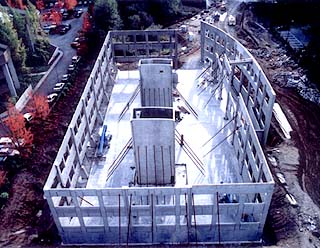
Tilt-up Structures Non-Industrial

Twilight Center in Bellevue.
Photo courtesy of WACA
Twilight Center
Location:2600 116th Ave. N.E., Bellevue
Owner/developer:Twilight Properties LLC
Project team:The Rafn Co., general contractor; DKS Inc.,
concrete contractor; Baylis Architects, architect; Coughlin Porter Lundeen, structural engineer; and Rinker Materials, ready-mix supplier
The Twilight Center office building in Bellevue used tilt-up concrete construction to provide an economical solution within a restricted site. The 35,000-square-foot building made use of a creative tilt-up design — it was curved.
Complementing the curve of a wetland on the site, the walls were made from a series of six curved panels. The smooth face of the curved concrete panels emphasize the curve, in contrast to the reveal patterning on the building’s flat concrete tilt-up panels.
The sloping concrete slab-on-grade parking garage under the office was used as the casting bed for the flat panels. Casting beds for the curved panels were located outside the building footprint. These casting beds were formed, poured and finished with a state-of-the-art screed that followed the curved forms. With the curved portion of the panels facing down, the panels were formed on the curved casting bed. Each window opening form was cut to fit the curve of the finished face. The back of the panel was finished flat, as that face would be covered by interior framing.
Designing the curved panels so that there was only 2.5 inches of difference from the center of each panel to the edge allowed for the thickness of the panel to be minimized, yet when all six panels were put in place, the curve stood out.
Each panel weighed about 130,000 pounds and required careful positioning with a 300-ton crane. A 4,000-psi concrete mix and precise window placement allowed the panels to be lifted with minimal strong-back requirements.
The decision to use concrete tilt-up panels for the curved feature came from extensive evaluation of all possible construction techniques. Structural steel, metal stud with veneer and masonry all had a higher cost due to requirements for extensive headers over the openings, while the concrete panels could compensate with additional bars within the panels. Also, since concrete tilt-up panels were the choice for 70 percent of the building, the cost to bring in another method became prohibitive.
Finalists included Quadrant’s East Campus Parcel II in Seattle’s Northlake area and the Forbes Lake office building in Kirkland.